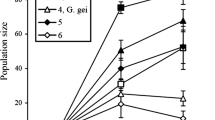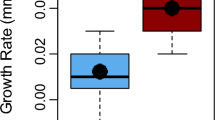Abstract
We suggest that the ultimate outcome of interactions between native species and invasive species (extinction or coexistence) depends on the number of simultaneous negative interactions (competition and predation), which depends on relative body sizes of the species. Multiple simultaneous interactions may constrain the ability of native species to trade fitness components (i.e., reduced growth for reduced risk of predation) causing a spiral to extinction. We found evidence for five types of interactions between the adults and juveniles of introduced western mosquitofish (Gambusia affinis) and the juveniles of native least chub (Iotichthys phlegethontis). We added ten large (23–28 mm) and seven small (9–13 mm) young-of-the-year (YOY) least chub to replicate enclosures with zero, low, and high densities of mosquitofish in a desert spring ecosystem. Treatments with mosquitofish reduced the average survival of least chub by one-third. No small YOY least chub survived in enclosures with high mosquitofish densities. We also performed two laboratory experiments to determine mortality to predation, aggressiveness, and habitat selection of least chub in the presence of mosquitofish. Mean mortality of least chub due to predation by large mosquitofish was 69.7% over a 3-h trial. Least chub were less aggressive, selected protected habitats (Potamogeton spp.), and were more stationary in the presence of mosquitofish where the dominance hierarchy was large mosquitofish>>large least chub≈small mosquitofish>>small least chub. Least chub juveniles appear to be figuratively caught in a vice. Rapid growth to a size refuge could reduce the risk of predation, but the simultaneous effects of competition decreased least chub growth and prolonged the period when juveniles were vulnerable to mosquitofish predation.



Similar content being viewed by others
References
Addicott JF, Aho JM, Antolin MF, Padilla DK, Richardson JS, Soluk DA (1987) Ecological neighborhoods: scaling environmental patterns. Oikos 49:340–346
Altmann J (1974) Observational study of behaviour: sampling methods. Behaviour 49:227–267
Ashton PJ, Mitchell DS (1989) Aquatic plants: patterns and modes of invasion, attributes of invading species and assessment of control programmes. In: Drake JA, Mooney HA, Di Castri F, Groves RH, Kruger FJ, Rejmànek M, Williamson M (eds) Biological invasions: a global perspective. Wiley, Chichester, pp 111–154
Barrier RFG, Hicks BJ (1994) Behavioral interactions between black mudfish (Neochanna diversus) and mosquitofish (Gambusia affinis). Ecol Freshw Fish 3:93–99
Belk MC, Whitney MJ, Schaalje GB (2001) Complex effects of predators: determining vulnerability of the endangered June sucker to an introduced predator. Anim Conserv 4:251–256
Bertolino S, Genovesi P (2003) Spread and attempted eradication of the grey squirrel (Sciurus carolinensis) in Italy, and consequences for the red squirrel (Sciurus vulgaris) in Eurasia. Biol Conserv 109:351–358
Brown JH (1989) Patterns, modes, and extents of invasions by vertebrates. In: Drake JA, Mooney HA, Di Castri F, Groves RH, Kruger FJ, Rejmánek M, and Williamson M (eds) Biological invasions: a global perspective. Wiley, Chichester, pp 85–110
Chapman LJ, Chapman CA, Schofield PJ, Olowo JP, Kaufman L, Seehausen O, Ogutu-Ohwayo R (2003) Fish faunal resurgence in Lake Nabnugabo, East Africa. Conserv Biol 17:500–511
Courtenay WR, Meffe GK (1989) Small fishes in strange places: a review of introduced Poeciliids. In: Meffe GK, Snelson FF Jr (eds) Ecology and evolution of livebearing fishes (Poeciliidae). Prentice Hall, Englewood Cliffs, pp 319–331
Crist L, Holden PB (1990) Aquatic biology study of a spring complex in Snake Valley, Utah final summary report Pr-36-1. Bio/West Inc, Logan
Crivelli AJ (1995) Are fish introductions a threat to endemic freshwater fishes in the Northern Mediterranean region. Biol Conserv 72:311–319
Elton CS (1958) The ecology of invasions by animals and plants. University of Chicago Press, Chicago
Fuller PL, Nico LG, Williams JD (1999) Nonindigenous fishes introduced into inland waters of the United States. American Fisheries Society, Special Publication 27, Bethesda, USA
Galat DL, Robertson B (1992) Response of endangered Poeciliopsis-Occidentalis sonoriensis in the Rio-Yaqui drainage, Arizona, to introduced Gambusia affinis. Environ Biol Fishes 33:249–264
Gamradt SC, Kats LB (1996) Effect of introduced crayfish and mosquitofish on California newts. Conserv Biol 10:1155–1162
Goldberg DE, Werner PA (1983) Equivalence of competitors in plant communities: a null hypothesis and a field experimental approach. Am J Bot 70:1098–1104
Goldsborough LG, Robinson GC (1996) Pattern in wetlands. In: Stevenson RJ, Bothwell ML, Lowe RL (eds) Algal ecology: freshwater benthic ecosystems. Academic, New York, pp 77–117
Goodsell JA, Kats LB (1999) Effect of introduced mosquitofish on Pacific treefrogs and the role of alternative prey. Conserv Biol 13:921–924
Gurevitch J, Morrison JA, Hedges LV (2000) The interaction between competition and predation: a meta-analysis of field experiments. Am Nat 155:435
Holden P, White W, Sommerville G, Duff D, Gervais R, Gloss S (1974) Threatened fishes of Utah. Utah Acad Sci Arts Lett 2:46–65
Hickman TJ (1989) Status report of the least chub (Iotichthys phlegethontis) prepared for the U.S. Fish and Wildlife Service. Western Ecosystems, St. George
Kiesecker JM, Blaustein AR, Miller CL (2001) Potential mechanisms underlying the displacement of native red-legged frogs by introduced bullfrogs. Ecology 82:1964–1970
Komak S, Crossland MR (2000) An assessment of the introduced mosquitofish (Gambusia affinis holbrooki) as a predator of eggs, hatchlings, and tadpoles of native and non-native anurans. Wildl Res 27:185–189
Kotler BP, Holt RD (1989) Predation and competition: the interaction of two types of species interactions. Oikos 54:256–260
Levin SA (1992) The problem of pattern and scale in ecology. Ecology 73:1943–1967
Lydeard C, Belk MC (1993) Management of indigenous species impacted by introduced mosquitofish: an experimental approach. Southwest Nat 38:370–373
MacArthur RH, Levins R (1964) Competition, habitat selection, and character displacement in a patchy environment. Proc Natl Acad Sci USA 51:1207–1210
Manly BFJ (1993) Comments on the design and analysis of multiple-choice feeding-preference experiments. Oecologia 93:149–152
McDonald AL, Heimstra NW, Damkot DK (1968) Social modification of agonistic behaviour in fish. Anim Behav 16:437–441
Meffe GK (1985) Predation and species replacement in American Southwestern fishes: a case study. Southwest Nat 30:173–187
Mittelbach GG (1986) Predator-mediated habitat use: some consequences for species interactions. Environ Biol Fishes 16:159–169
Mittelbach GG (1988) Competition among refuging sunfishes and effects of fish density on littoral zone invertebrates. Ecology 69:614–623
Mittelbach GG, Chesson PL (1987) Predation risk: indirect effects on fish populations. In: Sih A, Kerfoot CW (eds) Predation: direct and indirect impacts on aquatic communities. University Press of New England, Hanover, pp 315–332
Myers GS (1967) Gambusia, the fish destroyer. Aust Zool 13:102
Ogutu-Ohwayo R (1993) The effects of predation by Nile perch, Lates niloticus L., on the fish of lake Nabugabo, with suggestions for conservation of endangered endemic cichlids. Conserv Biol 7:701–711
Perkins MJ, Lentsch LD, Mizzi J (1998) Conservation agreement and strategy for least chub (Iotichthys phlegethontis). Utah Division of Wildlife Resources, Salt Lake
Rincon PA, Correas AM, Morcillo F, Risueno P, Lobon-Cervia J (2002) Interaction between the introduced Western mosquitofish and two autochthonous Spanish toothcarps. J Fish Biol 61:1560–1585
Sakai AK (2001) The population biology of invasive species. Annu Rev Ecol Syst 32:305–332
SAS Institute (1997) SAS/STAT software: changes and enhancements through release 6.12. SAS Institute, Cary
Savidge JA (1987) Extinction of an island avifauna by an introduced snake. Ecology 68:660–668
Schoener TW (1986) Overview: kinds of ecological communities–ecology becomes pluralistic. In: Diamond J, Case TJ (eds) Community ecology. Harper and Row, New York, pp 467–479
Sigler WF, Sigler JW (1987) Fishes of the Great Basin, a natural history. University of Nevada Press, Reno
Sigler WF, Miller RR (1996) Fishes of Utah. University of Utah Press, Salt Lake
Simberloff D (1989) Which insect introductions succeed and which fail. In: Drake JA, Mooney HA, Di Castri F, Groves RH, Kruger FJ, Rejmánek M, Williamson M (eds) Biological invasions: a global perspective. Wiley, Chichester, pp 61–76
Soderback B (1995) Replacement of the native crayfish Astacus astacus by the introduced species Pacifastacus leniusculus in a Swedish lake- possible causes and mechanisms. Freshw Biol 33:291–304
Tollrian R, Harvell CD (1999) The ecology and evolution of inducible defenses. Princeton University Press, Princeton
Townsend CR (1996) Invasion biology and ecological impacts of brown trout Salmo trutta in New Zealand. Biol Conserv 78:13–22
Wellborn GA (2002) Trade-off between competitive ability and antipredator adaptation in a freshwater amphipod species complex. Ecology 83:129–136
Werner EE, Anholt BR (1996) Predator-induced behavioral indirect effects: consequences to competitive interactions in anuran larvae. Ecology 77:157–169
Winkelman DL, Aho JM (1993) Direct and indirect effects of predation on mosquitofish behavior and survival. Oecologia 96:300–303
Wissinger SA (1992) Niche overlap and the potential for competition and intraguild predation between size-structured populations. Ecology 73:1431–1444
Acknowledgements
We gratefully acknowledge funding support from the Utah Division of Wildlife Resources and logistical support from Jay Banta and the staff at the Fish Springs National Wildlife Refuge. We thank Benjamin Shettell, Adrian Bell, and Amy Schweitzer for assistance in setting up our field experiment. This study was conducted under the approval of the Institutional Animal Care and Use Committee at Brigham Young University. Permits to collect the fish used in this study were provided by the Utah Division of Wildlife Resources.
Author information
Authors and Affiliations
Corresponding author
Rights and permissions
About this article
Cite this article
Mills, M.D., Rader, R.B. & Belk, M.C. Complex interactions between native and invasive fish: the simultaneous effects of multiple negative interactions. Oecologia 141, 713–721 (2004). https://doi.org/10.1007/s00442-004-1695-z
Received:
Accepted:
Published:
Issue Date:
DOI: https://doi.org/10.1007/s00442-004-1695-z




